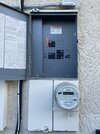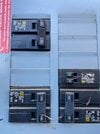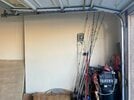I lived in California and the house was built 2008. The house has 2 circuit breaker, #1 is the Main Circuit Breaker located at the side of the house adjacent to the electric meter. On the otherside of these walls is my garage where I would like to install a Nema 14-50 wall socket. #2 circuit breaker is inside the house (by the laundry room), and it would too far to my garage and too many studs that requires 90 deg turns to run the 6 gauge wire would be very difficult or impossible to turn. I was wondering if it is OK to connect the Nema 14-50 outlet/wiring directly from the #1 Main Circuit Breaker? If ok anyone can anyone share maybe a photo or diagram of how to make the connections of the wiring and the 50 Amp breaker to my Main Circuit Breaker.
Welcome to Tesla Motors Club
Discuss Tesla's Model S, Model 3, Model X, Model Y, Cybertruck, Roadster and More.
Register
Install the app
How to install the app on iOS
You can install our site as a web app on your iOS device by utilizing the Add to Home Screen feature in Safari. Please see this thread for more details on this.
Note: This feature may not be available in some browsers.
-
Want to remove ads? Register an account and login to see fewer ads, and become a Supporting Member to remove almost all ads.
You are using an out of date browser. It may not display this or other websites correctly.
You should upgrade or use an alternative browser.
You should upgrade or use an alternative browser.
Nema 14-50 wiring into the Main Circuit Breaker
- Thread starter My Tessie
- Start date
HankLloydRight
No Roads
Two things --
First, those are "breaker boxes", and the switches inside are "circuit breakers."
Second, hire an electrician. They can easily run a 50amp run from the outside breaker box to an outlet in the garage. Unless you really know what you're doing, I would not recommend trying to DIY installing a new breaker into the outside panel.
First, those are "breaker boxes", and the switches inside are "circuit breakers."
Second, hire an electrician. They can easily run a 50amp run from the outside breaker box to an outlet in the garage. Unless you really know what you're doing, I would not recommend trying to DIY installing a new breaker into the outside panel.
ATPMSD
Active Member
Agree with @HankLloydRight, but unless you will be using the 14-50 for something other than your EV (which BTW you shouldn't) then consider installing a Wall Connector on a 60A circuit instead. In the case of a 14-50, if your electrician knows what they are doing, they will install a commercial grade 14-50 outlet ($80+) and a GFIC breaker ($!00+), and you will need to buy a 14-50 adapter for the mobile connector ($45) and will want some sort of cable management system ($35), which brings your parts total to $260, plus a markup by the electrician. On the other hand the Wall Connector with a standard breaker is about $560, which is $300 more. Plus wiring in both cases. So what do you get for that extra $300
- You can charge at 48 Amps instead of 32 (32 is the internal limit for the mobile connector)
- The mobile connector that came with the car can stay in the car - it will not be forgotten when needed
- If you add a 2nd Wall Connector in the future, power sharing is already build it
- The Wall Connector receives firmware updates. Item 3 was just such a update
Last edited:
Jenkins8
Member
Thank you for this! I was wondering the exact same...is a 6-50 better to install than the 14-50, appreciate the insight. I accept delivery in May 2022 of our M3LR.Agree with @HankLloydRight, but unless you will be using the 14-50 for something other than your EV (which BTW you shouldn't) then consider installing a Wall Connector on a 60A circuit instead. In the case of a 14-50, if your electrician knows what they are doing, they will install a commercial grade 14-50 outlet ($80+) and a GFIC breaker ($!00+), and you will need to buy a 14-50 adapter for the mobile connector ($45) and will want some sort of cable management system ($35), which brings your parts total to $260, plus a markup by the electrician. On the other hand the Wall Connector with a standard breaker is about $560, which is $300 more. Plus wiring in both cases. So what do you get for that extra $300
There is nothing wrong with the 14-50 approach! Just suggesting you consider your options. BTW, if you decide you do not want to spend the extra $300, then consider installing a 6-50 outlet instead of the 14-50 as this will save you some money on wiring. The 14-50 is a 120/240v plug and requires 3-conductors, the 6-50 is a 240v only plug and requires 2-conductors. EV chargers are 240v so unless you have a special need, running the extra wire is a waste of money.
- You can charge at 48 Amps instead of 32 (32 is the internal limit for the mobile connector)
- The mobile connector that came with the car can stay in the car - it will not be forgotten when needed
- If you add a 2nd Wall Connector in the future, power sharing is already build it
- The Wall Connector receives firmware updates. Item 3 was just such a update
TravelFree
Active Member
This is incorrect. The Tesla Gen 3 Wall connector MUST NEVER be connected to a GFCI breaker. It has it's own Ground Fault protection internally. If you knew the code and read the manual it specifically states to NOT use a GFCI breaker.In the case of a 14-50, if your electrician knows what they are doing, they will install a commercial grade 14-50 outlet ($80+) and a GFIC breaker ($!00+),
From Page 5 of the manual:
For maximum power output, install a standard double pole 60 amp circuit breaker. Wall Connector includes integrated GFCI protection - do not install a GFCI circuit breaker.
There is a good reason for this because you never run two GFCI protections on the same circuit as it will cause them to fail. This applies for the Mobile EVSE as well. This can be a problem for outside code outlets as they are GFCI protected. The Mobile charger will have problems with these exterior GFCI outlets.
The best advice given in this thread is: If you have to ask here you really should hire a Licensed Electrician. Many communities allow home owners to do certain DIY but that assumes you know what you are doing including the basics of the NEC and local codes.
Last edited:
ATPMSD
Active Member
What I stated is correct, you just missed it:This is incorrect. The Tesla Gen 3 Wall connector MUST NEVER be connected to a GFCI breaker. It has it's own Ground Fault protection internally. If you knew the code and read the manual it specifically states to NOT use a GFCI breaker.
On the other hand the Wall Connector with a standard breaker…
So to be clear, a GFIC is REQUIRED for the 14-50 and is should NOT be used with the Wall Connector.
And this is incorrect. If you use the moble connector you still MUST still use a GFIC breaker - this is code. The 14-50 GFIC breaker protects the wall outlet and the internal GFIC protects your car. If one breaker is causing the other to fail you have a different issue.The Mobile charger will have problems with these exterior GFCI outlets.
The only exception to this of which I am aware is if a 14-50 outlet is used to connect an RV, provided that only an RV will be connected to it. By code this is then designated as a “feeder” circuit and a GFIC breaker is not required.
TravelFree
Active Member
I apologize for misunderstanding what you are suggesting. I looked it up. The NEC was changed in Jan 1, 2019 to state that any NEMA 14-50 receptacle installed in a garage must use a GFCI breaker. Mine was installed before the code change.
Either way, what I have works with no trouble on both wall charger and Tesla's latest mobile EVSE as well as my Nissan EVSE. It was all code compliant at time of installation.
Some mobile EVSE has an internal GFI protection that trips below 1000ohms between ground and neutral. When you parallel two GFI systems this drops the trip level to 500 ohms and can cause frequent unnecessary shutdowns. The one outlet I used had a GFIC breaker and I had to remove it on that outlet to keep the EVSE from shutting down Tesla Gen 1 and my Nissan EVSE. I believe the new Tesla Mobile EVSE's eliminated this but the car still has it's own fault protection. There are many complaints from Tesla owners having trouble because of double GFIC on a circuit.And this is incorrect. If you use the moble connector you still MUST still use a GFIC breaker - this is code. The 14-50 GFIC breaker protects the wall outlet and the internal GFIC protects your car. If one breaker is causing the other to fail you have a different issue.
Either way, what I have works with no trouble on both wall charger and Tesla's latest mobile EVSE as well as my Nissan EVSE. It was all code compliant at time of installation.
Similar threads
- Replies
- 19
- Views
- 544
- Replies
- 31
- Views
- 2K
- Replies
- 57
- Views
- 1K
- Replies
- 5
- Views
- 403
- Replies
- 48
- Views
- 1K





